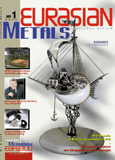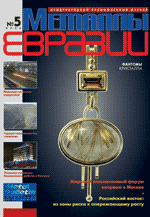|
| Magazine |
|
| About |
|
| SUMMIT |
|
| Contacts |
|
| Home |
|
|
|
|
|
| |











| |
 |
| #1' 2005 |
print version |
|
|
UKRAINIAN STEEL: FROM CRISIS TO CRISIS |
| Sometimes the Ukrainian steel industry is compared with the Russian fuel-and-energy complex in economic significance and position occupied in the national economic structure. In the crisis conditions this sector has become an original financial donor for the national economy and a base for a large national capital to be formed. After the crisis of the 1990s steel recovery gave an impetus to the development of conjugated sectors – coal and mining industries, machinebuilding, power engineering, transport. |
Yury Adno
ccording to the data of the Ukrainian Center of Economic Development the national steel industry accounts for over 17 % of industrial production and more than 30 % of foreign exchange incomings. Lately it has been promoted a lot by steel price growth.
In the world rating Ukraine is the seventh in steel production and one of the first in steel export. Its share in the world production of rolled steel was about 9 % in 2003.
The following may be attributed to traditional advantages of the Ukrainian steel industry:
- compact region of steel production based on 12 big works with 96 % of steel output located, for the most part, in the south-east of this country;
- relatively low transportation costs for raw materials and finished products due to a well-developed traffic system integrated into railway and water routes as well as motor roads of the European part of Russia and East-European countries;
- well-provided iron ore and fuel (coke) due to own resources (in 2003 coke and iron ore raw materials import was not more than 5.5 and 12.5 %, respectively);
- highly-skilled labor and a mature research base.
The positive result of the above advantages is greatly restricted owing to the problems of a technological lag of main production operations and a high wear rate of key facilities. Already at the time when Ukraine gained independence a lot of facilities requested reconstruction and modernization. Later on a shortage of investments also prevented a large-scale transformation in the steel industry. In 1985 - 2000, the total investment scope in the steel industry fell by over 6 times. As a result, the wear rate of the production facilities reached a critical value of 60 %, and even 70 % in the steelmaking operations. It causes higher resource costs in any operation and low production efficiency.
At present the investments per one ton of steel unit is US$7 to 9. This indicator in Russia and industrialized countries is US$15 and 25 to 30, respectively. The favorable steel market situation permits the current procedure of financing to be used in the Ukrainian steel industry. However, the funds received from export are adequate only for point equipment updating and for facilities to be kept efficient by means of repairs and partial reconstruction.
In Ukraine the investment climate and conditions of financial activity do not promote an inflow of foreign capital. A shortage of investment resources is also due to incomplete market transformations in this country. The markets of commodities and labor have already been formed while the market of capital is not mature as yet. The financial-and-industrial groups set up during privatization are far away from modern corporations in organizational structure and also behind Russian metallurgical holdings established relatively recently.
The production potential of the steel industry established in the Soviet times surpasses by far Ukraine’s requirements for steel products. It favored the reorientation of Ukrainian works to foreign markets and further growth of exports. In 1999 - 2003 the steel products exports grew 3.2 times. Now the share of export in total volume of sales is 78.8 %. In the opinion of Ukrainian analysts, the revival of the national industry is directly connected with the transformation into a big world exporter of steel products.
In the conditions of stiff competition, Ukrainian producers have been driven away from the most prestigious markets (USA and EU) and are now present, for the most part, in the peripheral and cheaper regional markets. They also failed to become firmly established as suppliers of value-added products. Nowadays the Ukrainian export consists of comparatively plain goods of hot-end production operations together with semifinished products. Lately the product structure has been certainly improved but the outdated technological base of production operations prevents a radical change. Nevertheless, Ukrainian companies are quite comfortable in this niche due to a stably high demand for semifinished products.
The financial-and-industrial groups prevailing over the national steel business try to make use of their partnership with foreign traders in order to strengthen their position in the world market. It can be exemplified by the interrelationship between the Industrial Union of Donbass and Duferco International Trading in sales of steel products and participation in acquisition of assets of steel plants in Hungary and Poland.
The Ukrainian steel industry retains competitiveness in the world market, above all, due to lower cost of main resources. In this country prices for raw materials and energy carriers are lower than in the world market. Moreover, the producers make use of favorable transport tariffs, cheap labor and low costs of environment protection. All the above makes it possible to offset high material intensity of products and low labor productivity.
Here the sector has a direct governmental support. Ten leading enterprises received benefits and deferred budget payments within the framework of the so-called "economic experiment". Their total amount for 1993-2003 is estimated at US$1.2 – 1.5 billion. According to the conditions of privatization, financial-and-industrial groups could long manage enterprises according to the scheme of "state cooperative benefits", i.e., virtually free of cost, and after that redeem their assets at reduced prices.
The non-market control managed at some time to give a hand to the most important sector of the Ukrainian economy in getting out of the crisis but at the same time decelerated the processes of structural transformation and modernization.
The outlook for the Ukrainian steel industry is ambiguous. The sector strongly needs a renovation of inefficient production operations, updating of main facilities, set-up of a full-fledged corporative sector. However, the joint financial capabilities of the state and national business do not so far permit these large-scale programs to be fulfilled to a required extent. The model of developing the steel complex chosen by the country’s leadership is as a matter of fact compulsory. Thus, by the assessment of the Center of Economic Development of Ukraine, a preservation of the previous state of the steel production operations is an alternate to an "economic death" of the regions where they are located in. Therefore the medium-term forecasts of Ukrainian analysts foresee a higher utilization rate as a major resource of steel industry growth though it faces a threat of an irreversible degradation of production instruments of the works/plants. In the opinion of the Center of Economic Development, such a model can retain the viability for 10 to 15 years ahead (which can hardly be agreed to with due regard to highly probable cyclic fluctuations of world market situation).
A pessimistic conclusion is very likely to be drawn to the effect that by preserving evident and acute illnesses of the steel industry the Ukrainian leadership takes the risk of getting problems that can shake the total national economy in the near future.
Table 1. Leaders of Ukrainian steel industry
_____________________________________________________________________________
Name Year of Production Main proprietor
foundation capacity, mill.tpy (financial-and-
of rolled steel industrial group)
_____________________________________________________________________________
Azovstal 1933 7.0 4.6 System Kapital Management
(SKM)
Alcheevsky Works 1885 4.5 3.2 Industrial Union of Donbass
(IUD)
Dzerzhinsky Works 1898 6.0 4.0 IUD
Petrovsky Plant 1885 1.2 1.4 Privat Group
Donetsky Plant 1872 1.2 1.0 Energo
Enakievo Plant 1897 2.8 1.5 SKM
Zaporozhstal 1933 4.4 3.7 Mowerton Ltd, Weybridge
Investments Ltd.
Krivorozhstal 1934 6.7 6.0 SKM, Interpipe
Makeevsky Works 1899 4.0 3.4 State
Ilyich Mariupol Works 1897 7.0 6.5 Ilyich Mariupol Works
ISTIL (mini-mill
based on Donetsky 1996 0.4 0.3 Energo
Works)
Mini-mill based on
Enakievo Works 2000 0.5 0.4 Metalen
According to the data of the Center of Economic development of Ukraine, 2004
Table 2. Comparative techno-economic indicators of steel industry in several countries (2003)
Indicator Russia USA Japan Ukraine
Structure of steelmaking operations, %
- basic oxygen process 61.9 51.1 73.6 48.9
- electric steelmaking 15.9 48.9 26.4 4.2
- open hearth process 22.2 – – 46.9
Continuous casting ratio 57.7 97.0 97.7 23.1
Steel yield per one ton of rolled products, kg/ton
1200 1150 1095 1250
Average through yield per one ton of rolled products, kg/ton
-iron ore materials 1480 1010 1070 1640
-coke 425 267 293 519
-hot metal 865 542 726 866
-scrap 446 677 488 490
Average steel output per one laborer, t/man-year
150 400 630 100
Average hourly remuneration rate, US$/man-hour
3.8 32 34 0.8
According to national statistics
Table 3. Forecast of steel production at Ukrainian steel works/plants
2004 – 2010
_____________________________________________________________________________
Indicators 2003. 2004 2005 2010
Production, mill.t 37.0 39.5 42.0 44.0
Growth rate, % 6.8 2.5 1.2
Production capacity, mill.t 42.1 43.0 44.0 46.0
Growth rate, % – 2.1 0 2.3
Utilization rate, % 87.9 91.9 93.0 93.2
According to the data of the Center of Economic development of Ukraine, 2004
Fig. 1. Position of Ukraine in rating of world steel production leaders (2003), mill. t
China 220.1
Japan 110.5
USA 91.4
Russia 61.3
South Korea 46.3
Germany 44.8
Ukraine 37.5
India 31.8
Brazil 31.1
Italy 26.7
France 19.8
0 50 100 150 200
________________
Source: IISI
Fig. 2. Export geography of Ukrainian steel products
January to June 2004
CIS – 11 %
Africa – 11 %
EU – 25 %
East Europe – 6 %
Asia – 34 %
Middle East – 22 %
North America – 3 %
Latin America – 2 %
__________________
Source: Metallurgical Bulletin (Russia), 2004, No.9-20.
Fig. 3. Export structure type-wise (in terms of US$ cost)
100 %
50 %
0 %
20.9 25.1 29.5 25.9 26.8
32.4 33.9 31.6 35.0 36.7
46.7 41.0 39.0 39.1 36.5
long products
flat products
semifinished products
1999 2000 2001 2002 2003
____________________
Source: Center of Economic development of Ukraine, 2004.

|
|
|
|
|
|
current issue


previous issue


russian issue


|
|






 back
back


